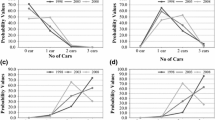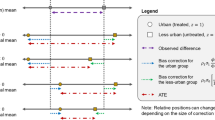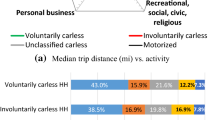Abstract
We estimate the effect of carsharing on travel behavior (specifically, household vehicle holdings, frequency of transit usage, and frequency of biking and walking) using data from the 2011–2012 California Household Travel Survey (CHTS). The effect of carsharing on vehicle ownership is a dynamic process that plays out over a period of time—past ownership influences enrollment decisions, which in turn influence holdings in a later period. Representing this process using cross-sectional data conflates causal effects with simultaneity bias. Further, members and non-members differ in various observed and unobserved ways—demographics, built environment of residential and workplace location, and attitudes—raising the potential for self-selection bias in comparing travel behavior between the two groups given the observational nature of the data. Drawing on established methods for dealing with each bias individually, we develop a method to help control for this joint occurrence of self-selection and simultaneity biases. Restricting the analysis to employed respondents residing in the San Francisco Bay Area, we find that 80% of the observed difference of 0.9 units in average vehicle holdings between carsharing non-members and members may be explained by the biases listed above. The remaining difference of 0.17 units reflects the estimated effect of carsharing, which is the equivalent of shedding one vehicle by about one out of every six households whose member(s) are enrolled in carsharing. The effect on transit usage and walking and biking frequency is positive, albeit small and statistically non-significant. We identify factors that may affect the internal and external validity of our results. Our methods cannot completely replace randomized experiments or panel data. However, the methods used here provide a way to help control for the joint occurrence of self-selection and simultaneity biases, and provide a ballpark estimate of causal effects, for large-scale, general-purpose, cross-sectional datasets such as the CHTS.



Similar content being viewed by others
References
Angrist, J., Pischke, J.-S.: Mostly Harmless Econometrics: An Empiricist’s Companion. Princeton University Press, Princeton (2008)
Austin, P.C.: An introduction to propensity score methods for reducing the effects of confounding in observational studies. Multivar. Behav. Res. 46(3), 399–424 (2011). doi:10.1080/00273171.2011.568786
Bagozzi, R.P., Yi, Y.: Specification, evaluation, and interpretation of structural equation models. J. Acad. Mark. Sci. 40(1), 8–34 (2012). doi:10.1007/s11747-011-0278-x
Bertrand, M., Mullainathan, S.: Do people mean what they say? Implications for subjective survey data. Am. Econ. Rev. 91(2), 67–72 (2001)
Bhat, C.R., Pulugurta, V.: A comparison of two alternative behavioral choice mechanisms for household auto ownership decisions. Transp. Res. Part B Methodol. 32(1), 61–75 (1998)
Bollen, K.A., Noble, M.D.: Structural equation models and the quantification of behavior. Proc. Natl. Acad. Sci. 108(Supplement 3), 15639–15646 (2011). doi:10.1073/pnas.1010661108
Bollen, K.A., Pearl, J.: Eight myths about causality and structural equation models. In: Morgan, S.L. (ed.) Handbook of Causal Analysis for Social Research, pp. 301–328. Springer, New York (2013)
Brookhart, M.A., Schneeweiss, S., Rothman, K.J., Glynn, R.J., Avorn, J., Stürmer, T.: Variable selection for propensity score models. Am. J. Epidemiol. 163(12), 1149–1156 (2006)
Caltrans: 2010–2012 California Household Travel Survey Final Report. California Department of Transportation (2013)
Cervero, R., Golub, A., Nee, B.: City CarShare: longer-term travel demand and car ownership impacts. Transp. Res. Rec. J. Transp. Res. Board 1992(1), 70–80 (2007)
Clewlow, R.R.: Carsharing and sustainable travel behavior: results from the San Francisco Bay Area. Transp. Policy (2016). doi:10.1016/j.tranpol.2016.01.013s
Elwert, F., Winship, C.: Endogenous selection bias: the problem of conditioning on a collider variable. Ann. Rev. Sociol. 40, 31–53 (2014). doi:10.1146/annurev-soc-071913-043455
Firnkorn, J., Müller, M.: Selling mobility instead of cars: new business strategies of automakers and the impact on private vehicle holding. Bus. Strategy Environ. 21(4), 264–280 (2012). doi:10.1002/bse.738
Greene, W.H., Hensher, D.A.: Modeling Ordered Choices—A Primer. Cambridge University Press, Cambridge (2010)
Handy, S., Cao, X., Mokhtarian, P.: Correlation or causality between the built environment and travel behavior? Evidence from Northern California. Transp. Res. Part D Transp. Environ. 10(6), 427–444 (2005). doi:10.1016/j.trd.2005.05.002
Heckman, J.J., Ichimura, H., Smith, J., Todd, P.: Sources of Selection Bias in evaluating social programs: an interpretation of conventional measures and evidence on the effectiveness of matching as a program evaluation metho. Proc. Natl. Acad. Sci. 93(23), 13416–13420 (1996)
Ho, D.E., Imai, K., King, G., Stuart, E.A.: Matching as nonparametric preprocessing for reducing model dependence in parametric causal inference. Political Anal. 15(3), 199–236 (2007)
Ho, D.E., Imai, K., King, G., Stuart, E.A.: MatchIt: Nonparametric Preprocessing for Parametric Causal Inference—R Package Version 2.4-21 (2013)
Imbens, G.W., Rubin, D.B.: Causal Inference in Statistics, Social, and Biomedical Sciences. Cambridge University Press, New York (2015)
Kline, R.: Assumptions in Structural equation modeling. In: Hoyle, R.H. (ed.) Handbook of Structural Equation Modeling. Guilford Publications, New York (2012)
Kline, R.B.: Principles and Practice of Structural Equation Modeling, 3rd edn. Guilford press, New York (2011)
Kopp, J., Gerike, R., Axhausen, K.W.: Do sharing people behave differently? An empirical evaluation of the distinctive mobility patterns of free-floating car-sharing members. Transportation 42(3), 449–469 (2015). doi:10.1007/s11116-015-9606-1
Loose, W.: The State of European Car-Sharing, p. 129. Bundesverband CarSharing e. V., Freiburg (2010)
Madalla, G.: Limited-Dependent and Qualitative Data in Econometrics, vol. 3. Cambridge University Press, Cambridge (1983)
Martin, E., Shaheen, S.A., Lidicker, J.: Impact of carsharing on household vehicle holdings. Transp. Res. Rec. J. Transp. Res. Board 2143(1), 150–158 (2010). doi:10.3141/2143-19
McKelvey, R.D., Zavoina, W.: A statistical model for the analysis of ordinal level dependent variables. J. Math. Sociol. 4(1), 103–120 (1975)
Mishra, G.S., Clewlow, R.R., Mokhtarian, P.L., Widaman, K.F.: The effect of carsharing on vehicle holdings and travel behavior: a propensity score and causal mediation analysis of the San Francisco Bay Area. Res. Transp. Econ. 52, 46–55 (2015). doi:10.1016/j.retrec.2015.10.010
Mokhtarian, P.L., Cao, X.: Examining the impacts of residential self-selection on travel behavior: a focus on methodologies. Transp. Res. Part B Methodol. 42(3), 204–228 (2008). doi:10.1016/j.trb.2007.07.006
Morgan, S.L., Winship, C.: Counterfactuals and Causal Inference, 2nd edn. Cambridge University Press, New York (2014)
Moulton, B.R.: An illustration of a pitfall in estimating the effects of aggregate variables on micro units. Rev. Econ. Stat. 72, 334–338 (1990)
Muthén, B.: Applications of causally defined direct and indirect effects in mediation analysis using SEM in Mplus (Technical Report). Muthén & Muthén, Los Angeles, CA. http://statmodel2.com/download/causalmediation.pdf (2011)
Muthén, L.K., Muthén, B.O.: Mplus User’s Guide, 7th edn. Muthén & Muthén, Los Angeles (1998–2014)
Rubin, D.B.: Using propensity scores to help design observational studies: application to the tobacco litigation. Health Serv. Outcomes Res. Method. 2(3–4), 169–188 (2001). doi:10.1023/A:1020363010465
Rubin, D.B.: Comment: the design and analysis of gold standard randomized experiments. J. Am. Stat. Assoc. 103(484), 1350–1356 (2008)
Shaheen, S.A., Cohen, A.P., Chung, M.S.: North American carsharing—10-year retrospective. Transp. Res. Rec. J. Transp. Res. Board 2110(1), 35–44 (2009)
Sioui, L., Morency, C., Trépanier, M.: How carsharing affects the travel behavior of households: a case study of Montréal, Canada. Int. J. Sustain. Transp. 7(1), 52–69 (2013). doi:10.1080/15568318.2012.660109
Waddell, P., Bhat, C., Eluru, N., Wang, L., Pendyala, R.: Modeling interdependence in household residence and workplace choices. Transp. Res. Rec. J. Transp. Res. Board (2007). doi:10.3141/2003-11
Xie, Y.: Structural equation models for ordinal variables an analysis of occupational destination. Sociol. Methods Res. 17(4), 325–352 (1989)
Xie, Y.: Population heterogeneity and causal inference. Proc. Natl. Acad. Sci. 110(16), 6262–6268 (2013). doi:10.1073/pnas.1303102110
Acknowledgements
This study has benefited from the input and critical comments of several anonymous referees; various researchers including Kenneth Laberteaux from the Toyota Research Institute of North America; Susan Handy, Gil Tal, Sonia Yeh, Lewis Fulton, David Bunch and Joan Ogden, all from the Institute of Transportation Studies at UC Davis; and James Sweeney from Stanford University. We are also grateful to Karim Hamza for help with obtaining accessibility scores. The views and opinions expressed in this paper are those of the authors alone. The authors declare no conflict of interest.
Author information
Authors and Affiliations
Corresponding author
Rights and permissions
About this article
Cite this article
Mishra, G.S., Mokhtarian, P.L., Clewlow, R.R. et al. Addressing the joint occurrence of self-selection and simultaneity biases in the estimation of program effects based on cross-sectional observational surveys: case study of travel behavior effects in carsharing. Transportation 46, 95–123 (2019). https://doi.org/10.1007/s11116-017-9791-1
Published:
Issue Date:
DOI: https://doi.org/10.1007/s11116-017-9791-1




